What if you launch a revolution and nobody comes?
Nothing short of automotive insurgency was what Daimler-Benz and its partner, Swiss watch company Swatch, had in mind when they originally conceived the idea of Smart in 1994. Their goal was to launch a small car brand perfectly tuned to the world’s fast-growing megacities, something hip, affordable, easy to maneuver on crowded streets and environmentally friendly.
Four years later, Swatch had dropped out of the project, the German maker was about to become DaimlerChrysler, and the Smart brand was to generate little of the enthusiasm originally anticipated — though a lot more red ink. That soon forced the maker to abandon all but the two-seat ForTwo.
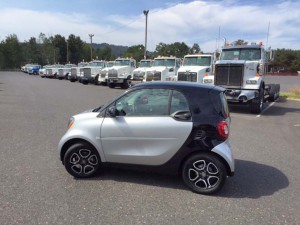
A new Smart ForTwo pauses alongside some of the biggest vehicles on the road, Western Star 18-wheelers also produced by Daimler AG.
In the U.S., Smart came late and generated few sales but plenty of negative reviews. After a seemingly interminable delay, what is now Daimler AG has finally launched a second-generation ForTwo. Could it finally muster the revolutionary enthusiasm long promised? That was something that lured us to Portland, Oregon for a first drive.
The location was appropriate. With its motto, “Keep Portland Weird,” the Northwest city is almost painfully hip and green conscious. It has narrow, crowded streets that are increasingly dominated by bicycle traffic. And it is one of the few places that has come close to embracing the original Smart car, the number of ForTwo microcars on the road there doubling over the last year, according to Daimler.
There even are plenty of parking spots that have been reserved exclusively for ForTwo drivers, it turns out, though they all were empty until we parked one of the new 2016 models in a garage downtown one recent afternoon. We did get to see an older model rented through the Car2Go carsharing program drive by, however, and that helped us see how much the 2016 ForTwo has changed – and how it has stayed the same, not always to its advantage.
The new model, it should be noted, comes to market as a result of a new joint venture, this one between Daimler and Renault. The French carmaker has its own version, the Twingo, that won’t make it to the American market.
While both are two-seaters with their engines mounted in the rear, they feature different designs, and key structural differences. For the Smart ForTwo, the most notable is the so-called Tridion cell, a hardened, high-strength steel shell around the cabin intended to channel crash loads away from passengers.
At first glance, it’s easy to confuse the old and new versions of the ForTwo, though a closer inspection reveals a number of visual changes. The revised grille has an upturned shape that makes it appear to be smiling. It’s framed by larger headlamps and new LED daytime running lights. From the side, you’d be hard-pressed to tell old and new Smart cars apart, In back, new taillamps are a bit squarer than before.
(Click Here to check out the Smart ForTwo Cabrio coming in 2016.)
One reason they seem so similar is that Daimler insisted on hewing to the original car’s 8.8-foot length, nose-to-tail. That makes it not only maneuverable in tight traffic – with a turning radius of just 22.8 feet – but able to park in a conventional spot sideways.
For passengers, the good news is that the 2016 Smart ForTwo has gained about three more inches in width. That doesn’t quite make the word, “roomy” come to mind, two adult passengers will no longer be banging elbows.
Inside, Smart has not only provided more room but upgraded the use of materials, giving the 2016 ForTwo a bit more lavish and refined feel, though it is by no means a luxury car. Spend a few minutes inside and you’ll discover a number of new standard features, including Bluetooth connectivity, a CD player, power windows, air conditioning and more.
While the little car might be maneuverable, that 8.8-foot bogey did result in some serious drawbacks, as well. The cargo compartment, accessed through a two-piece hatch, will barely handle two large carry-on bags — three if you don’t care about rear visibility. A childless couple might squeeze in a week’s groceries, but forget going to CostCo. There’s a wee bit more room hidden under the tailgate’s inside cover but it would be a challenge to squeeze in most purses.
Up front, meanwhile, awkwardly removing the flimsy plastic cover provides access to accessories like the battery and washer fluid, but no more storage.
Getting to the engine, tucked under the seats and cargo bay, can be a challenge. If you work at it, you’ll find an all-new powertrain for the 2016 ForTwo remake. The 0.9-liter turbocharged three-cylinder package makes a modest 89-horsepower and 100 pound-feet of torque. It’s definitely quicker than the original microcar. That’s a relative term, though, as you’ll still need 10.1 seconds to launch to 60, but for those driving around on city streets that might not matter all that much.
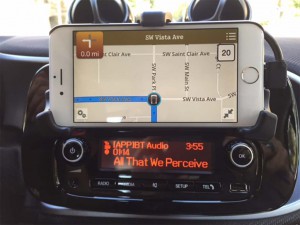
Smart will offer a suite of features, including navi, run by a smartphone, but the mount partially obstructs the radio.
The good news is that Smart is not only offering a 5-speed stick but that it has replaced the original car’s much criticized single-clutch manumatic gearbox in favor of a new double-clutch design. It is, on the whole, much smoother, though still prone to occasional jerks when downshifting. The three-cylinder engine occasionally shuddered at idle, though that seemed to vanish as it warmed up.
On the road, the new Smart ForTwo is noticeably quieter and feels more confident than before. The new power steering system offers a reasonable amount of road feel – and makes it so easy to check out that 22.8-foot turning circle you might want to just spin it around a bunch of times.
As with the original microcar, the new ForTwo is primarily designed for urban driving, but the new model will likely make you feel less nervous on the freeway – though here is a bit of body roll and pitch in corners.
To ensure stability, Smart has borrowed the Mercedes Crosswind Assist system, a feature that counters the effects a heavy wind could have on this rolling block of plastic, metal and glass. Meanwhile, a video provided by Smart shows just how effective the Tridion cell can be. Even after smashing head-on into a 5,000-pound Mercedes, the passenger compartment remains essentially intact.
One downside is that the design of the cell requires huge back pillars that reduce rear visibility notably.
What could come as the real disappointment for potential buyers, however, is fuel economy. Though better than the original, the 2016 Smart ForTwo is rated by the EPA at only 33 miles per gallon City, 39 Highway, and 36 mpg in the Combined cycle. Considering there are some small four-seaters on the market that nudge into 40 mpg territory, and hybrids that handily top 50, this just doesn’t impress.
And our real-world experience was even less inspiring. Admittedly, we were sent off on a high-tech scavenger hunt that sucked down more gas than a motorist might normally need to run around-town errands, but we barely got out of the mid-teens, a figure close to – and in some cases better than – what colleagues on the media drive reported.
That scavenger hunt, incidentally, relied on a special app that Smart is currently developing for the new ForTwo. It was a bit buggy but promising. The maker hopes to connect with a generation of tech-savvy Millennials who have come to depend on their smartphones. So, a buyer could order either a built-in navigation system or opt for the accessory phone holder and use the Smart Cross Connect infotainment system. It provides a suite of apps, including a low-cost navigation package.
Awkwardly, however, the mount places a smartphone right in front of the smaller audio head unit making it difficult to reach some key controls. But many features then can be controlled through the phone’s apps, so it might not matter.
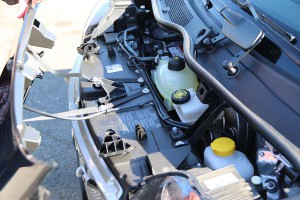
The "hood" actually conceals things like the battery and washer fluid bottle. The engine in the Smart ForTwo is rear-mounted.
This digital customization reflects some of the ways Smart’s business strategy has evolved since the brand was first conceived. Back in the mid-1990s, the maker planned to allow ForTwo buyers the ability to swap out its lightweight body panels so they could, for one thing, change colors. That idea never came to fruition, but Smart brand boss Annette Winkler told us the goal is now to offer a number of smaller, customizable options – a move that borrows a successful page from rival Mini’s playbook.
(Little Smart has big global ambitions. Click Here for the story.)
Will buyers embrace the second-generation Smart ForTwo. Winkler noted that global sales are up 30% so far this year, and she hopes to see even more growth as production of the new model ramps up. In a select list of cities, Rome among them, the microcar has developed a real following that the remake should connect with.
In the U.S., however, sales have continued to tumble at a double-digit rate this year, and it’s anyone’s guess if the remake will reverse the brand’s fortunes.
Pricing could prove an obstacle, the base 2016 Smart ForTwo starting at $15,400, including delivery charges. There are a number of roomier and often more fuel-efficient alternatives on the market for that money. The well-reviewed Honda Fit, for example, gives you two more seats, lots more flexible storage space – and the same EPA Combined fuel economy rating for barely $1,000 more.
That said, the second-generation microcar does have a peculiar charm about it, and for those who live in cities where traffic and parking present serious obstacles, the new Smart just might make sense. It’s not going to appeal to mainstream buyers, but the remake is likely to build up Smart’s small but often loyal following in the U.S., as well.
The addition of a new Cabriolet version next year could enhance the microcar’s appeal, and green-minded buyers will soon see a new ForTwo ED, or Electric Drive, model, as well. But we’ll have to wait to see if American motorists finally think Daimler’s Lilliputian two-seater really is a Smart buy.
(August sales show small and green-minded products continued losing traction. Click Herefor the story.)

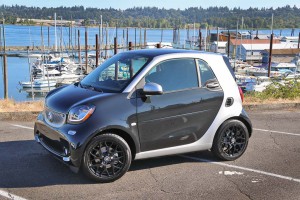
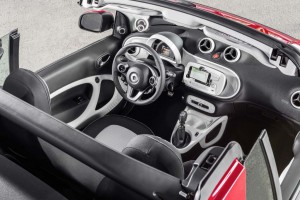
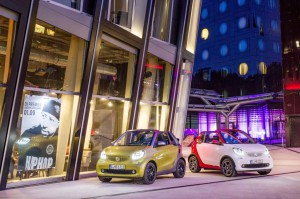
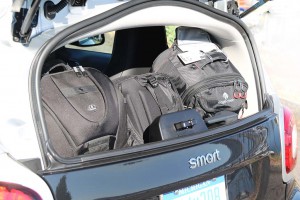
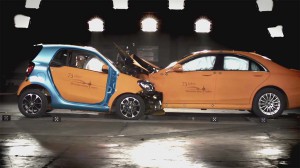
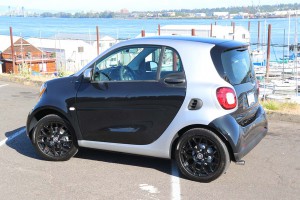
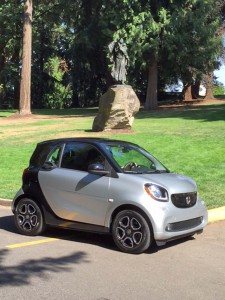
Most people would only buy these things for the novelty factor. I saw one in Germany on a rural road with a line of traffic behind it with people blowing their horns as the not so Smart car was doing about 45 kph in a 100 kph zone.
The crash video picture might look impressive until you understand that the more rigid the crash structure, the higher the peak energy imposed on the occupants. That’s why most auto makers use crash zones to gradually compress on impact which lowers the peak loads exerted on the body. With no room for energy absorption the body takes it all at once.
Jorge, the original Smart did surprisingly well in NHTSA and IIHS tests. Yes, crush zones are important — see how much the Mercedes crumples in the image — but the Tridion concept efficiently transfers a lot of crash energy to the structure around the passenger compartment to reduce crash forces. The full video is illustrative. You see how well the dummy fares in the Smart.
Paul E.
Dummies are not humans… Well some dummies are. LOL
Yes some of the forces are distributed around the vehicle but the laws of physics have not changed. An object in motion remains in motion until stopped or forced to change direction. That means the passengers are going to have a more sudden stop with minimal crush zones than with larger ones that provide more energy dissipation. That is one of the unfortunate shortcomings of all cars.
NHTSA and IIHS test don’t tell the entire story. As I have noted in the past a simple one degree change in overlap impact testing can yield dramatically different results than what is reported. It’s a lot like the EPA specified mpg tests. Car makers can make the cars look good in the test but real world results can vary significantly from the lab tests. That’s why it’s foolish to base car buying decisions exclusively on crash impact safety ratings because they may or may not be accurate in any given real world crash.
BTW, Mythbusters did a story recently on a person sitting in the back seat of a car being hit by a large truck at 50 mph in a side impact (T-bone) crash. The theory was that if a average size person sat in the rear seat between two larger framed people, in a side impact the average sized person would be able to use the two people to cushion the impact to their body and survive the accident.
As it turned out with assistance from impact specialists and medical doctors, they determined from instrumented dummies that the person riding in between the two larger people would be subjected to higher impact forces with a total force above 800 g’s @ 50 mph, when hit by a truck and that it would be instant death. With the person riding in the back seat by their self, they still would have died from many major injuries but the total impact force was lower than being in between two large humans.
Does Mercedes say what they project for manual trans take rate? I wonder if in a city car many people will want it, since all you’d be doing is shifting.
Likely single digits in the U.S.